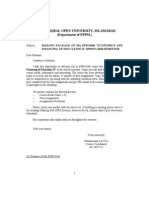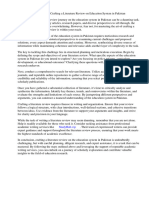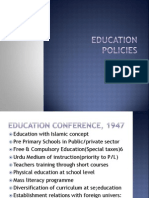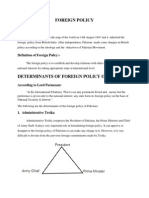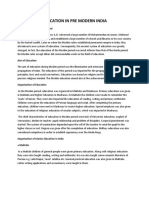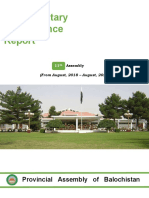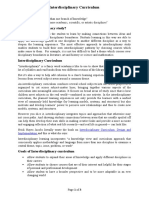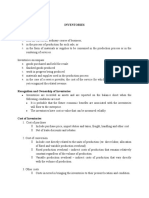0 ratings0% found this document useful (0 votes)
84 viewsHigher Education Commision of Pakistan
Higher Education Commision of Pakistan
Uploaded by
Ammar SaleemHigher education in Pakistan refers to education above grade 12, which is overseen by the Higher Education Commission of Pakistan (HEC). The HEC funds public universities and some private universities. It aims to improve quality, access, governance, and financial sustainability in higher education through six pillars of reform. However, the higher education system faces challenges due to uncertainty after provinces gained control over education, underfunding of the HEC, delays in funding releases, and high turnover in HEC leadership.
Copyright:
© All Rights Reserved
Available Formats
Download as DOCX, PDF, TXT or read online from Scribd
Higher Education Commision of Pakistan
Higher Education Commision of Pakistan
Uploaded by
Ammar Saleem0 ratings0% found this document useful (0 votes)
84 views4 pagesHigher education in Pakistan refers to education above grade 12, which is overseen by the Higher Education Commission of Pakistan (HEC). The HEC funds public universities and some private universities. It aims to improve quality, access, governance, and financial sustainability in higher education through six pillars of reform. However, the higher education system faces challenges due to uncertainty after provinces gained control over education, underfunding of the HEC, delays in funding releases, and high turnover in HEC leadership.
Original Title
HIGHER EDUCATION COMMISION OF PAKISTAN.docx
Copyright
© © All Rights Reserved
Available Formats
DOCX, PDF, TXT or read online from Scribd
Share this document
Did you find this document useful?
Is this content inappropriate?
Higher education in Pakistan refers to education above grade 12, which is overseen by the Higher Education Commission of Pakistan (HEC). The HEC funds public universities and some private universities. It aims to improve quality, access, governance, and financial sustainability in higher education through six pillars of reform. However, the higher education system faces challenges due to uncertainty after provinces gained control over education, underfunding of the HEC, delays in funding releases, and high turnover in HEC leadership.
Copyright:
© All Rights Reserved
Available Formats
Download as DOCX, PDF, TXT or read online from Scribd
Download as docx, pdf, or txt
0 ratings0% found this document useful (0 votes)
84 views4 pagesHigher Education Commision of Pakistan
Higher Education Commision of Pakistan
Uploaded by
Ammar SaleemHigher education in Pakistan refers to education above grade 12, which is overseen by the Higher Education Commission of Pakistan (HEC). The HEC funds public universities and some private universities. It aims to improve quality, access, governance, and financial sustainability in higher education through six pillars of reform. However, the higher education system faces challenges due to uncertainty after provinces gained control over education, underfunding of the HEC, delays in funding releases, and high turnover in HEC leadership.
Copyright:
© All Rights Reserved
Available Formats
Download as DOCX, PDF, TXT or read online from Scribd
Download as docx, pdf, or txt
You are on page 1of 4
HIGHER EDUCATION IN PAKISTAN AND HIGHER
EDUCATION COMMISION OF PAKISTAN
Higher Education in Pakistan:
In Pakistan, higher education refers to education above grade 12,
which generally corresponds to the age bracket of 17 to 23 years. The higher education system in
Pakistan is made up of two main sectors: the university/Degree Awarding Institutes (DAI) sector
and the affiliated Colleges sector.
Colleges are funded and regulated by provincial governments, but follow
the curriculum of the HEC funded universities/DAIs with which they are affiliated. While the
HEC primarily funds public universities, it has recently opened a limited number of avenues for
making funds available to private sector universities for research and infrastructure development.
The Pakistan higher education sector is predominantly public in nature, with public Higher
Education Institutions (HEIs) dominating both the university/DAI and College sectors.
The HE sector enrolls less than 4% (including colleges) of the age cohort, and compares
unfavorably with countries such as India at 11% and Malaysia at 32%. There is also a large
distance learning program. Public HEIs generally offer a wide range of courses and programs,
while private HEIs predominantly offer a narrow range of vocationally oriented courses and
programs such as business and IT.
Government Strategy and Ongoing Policy Reforms:
After two decades of serious neglect, the higher education (HI) sector in Pakistan has, in
recent years, undergone a rebirth. The situation began to reverse itself in the early 2000s, with
the government showing a clear commitment to improving higher education, as evidenced by
significant increases in spending on higher education, the creation of the HEC in 2002 and the
establishment of an ongoing major policy reform program outlined in the Medium-Term
Development Framework (MTDF) 2005- 2010 prepared by the Higher Education Commission.
Recent developments in the areas of quality, access, and governance and management include:
1. Quality:
1.1 establishment of Quality Assurance Agency at the HEC and Quality Enhancement
Cell at HEIs
1.2 a program launched to equip both new and existing faculty with the advanced
qualifications
1.3 introduction of a new compensation system (Tenure Track System)
1.4 Provision for laboratories, equipment and scientific material
1.5 Alignment of academic degrees
with international norms; and
1.6 Curriculum revision.
2. Access - measures have been taken both to expand supply and to boost demand
2.1 Expansion of existing infrastructure
2.2 exploitation of the potential of distance learning; and
2.3 Provision of undergraduate and post-graduate scholarships to students in both the public
and private sectors.
3. Governance:
3.1 implementation of measures to introduce a culture of accountability in
Universities/DAI, to clarify administrative procedures, and to institute transparent quality
assurance mechanisms; and
3.2 Strengthening capacity of HEC through streamlining of financial
management and procurement procedures, and stakeholder consultations.
As a result of the reforms introduced since 2002, the higher education sector has made
some progress toward addressing the significant issues and challenges that faced the sector at
the turn of the 21st Century. The impact of these initial measures has been substantial, and
the results can be seen at both the University/DAI and HEC levels.
Higher Education Commission (HEC):
The Higher Education Commission (HEC) is an autonomous apex body responsible for
allocating public funds from the federal government to universities and DAIs and accrediting
their degree programs, in Pakistan. Colleges are funded and regulated by provincial
governments, but follow the curriculum of the HEC funded universities/DAIs with which they
are affiliated.
Pillars of Higher Education Commission:
HEC is supporting initiatives aimed at enhancing collaboration between academia and
industry, with a particular focus on the development of locally relevant education and
research and development programs in the academic institutions. To achieve these
strategic aims and objectives (institutions focusing on building economies, leadership and
communities), the MTDF-II was organized around six pillars of institutional development:
a. faculty development
b. quality assurance
c. research, innovation and entrepreneurship
d. improving equitable access
e. excellence in leadership and governance
f. Financial management and sustainability.
A separate section of the plan was set out, for each of these pillars which covers:
1. The aim in full is to say, the high-level strategic outcome towards which HEC is
working throughout and beyond the life of this plan.
2. An introduction providing a commentary outlining the strategic context and
challenges.
3. The strategic objectives that HEC seeks to achieve within the plan period.
4. The major programs that HEC intends to implement as a means to achieving the
stated objectives.
5. Key Performance Indicators by which HEC plans to demonstrate, in measureable
terms, progress towards attaining the set aim and objectives.
Academic Supervision of Higher Education Sector in Pakistan:
The HEC Pakistan is an independent, autonomous, and constitutionally established
institution of primary funding, overseeing, regulating, and accrediting the higher
education efforts in the country through the above mentioned institutions. It has three sub offices,
one each in Karachi, Lahore, and Peshawar. Higher Education Commission (HEC) serves many
purposes such as, faculty development, HEC infrastructure
advancement, curriculum review, indigenous and foreign scholarships, conference travel
supports, improvements of university as well as industry research cooperation and flourishing of
latest technology parks. HEC is segregated into departments to run its business
professionally, these include;
Human Resource Development Division
Academic Division
Learning and Innovation Division
Service Division
Finance Division and,
Quality Assurance Division
These divisions, academically oversee the academic quality of the programs offered by
and in some cases, managerial aspects of the universities across the country, as per
manmade given to Higher Education Commission (HEC) in its ordinance.
Administrative Supervision of Higher Education sector in Pakistan:
After, the 18th Constitutional Amendment, every province is responsible for managing
education at all levels including tertiary/higher education in the province. Two provinces i.e.
Khyber Pakhtunkhwa and Punjab have separate administrative departments with tile: Higher
Education Department. Whereas in other two provinces i.e. Baluchistan and Sindh higher
education is dealt with by the same administrative departments which are dealing
with school education. Province-wise complete administrative hierarchy of higher education
is given as Appendix 3. Two provinces i.e. Punjab and Sindh have gone a step forward and
have established Provincial Higher Education Commission through their respective
legislation body i.e. Provincial Assembly.
Federal Vs Provisional HECs:
As mentioned above, during the last few years the provincial governments of Sindh and
Punjab established their respective provincial higher education commissions, i.e., Sindh HEC
and Punjab HEC. Such provincial bodies are yet to be formed, if any, by the
governments of Khyber Pakhtunkhwa and Baluchistan. As the situation unfolded, the need
was felt to define the roles of all the three HECs. In this
regard, The Federal Government constituted a committee, headed by Minister for Planning
and Reforms. The committee has held three meetings so far and has yet to finalize its
recommendations. The provinces argue that under the 18th Amendment to the constitution,
education has been made a provincial subject and it is the right of provinces to set up their
own bodies. Nonetheless, HEC officials argue that the Supreme Court, in its 2011
judgment, made it clear that “the status of HEC shall remain intact unless it is changed
through new legislation.”
Challenges and Constraint of Higher Education:
A situation of uncertainty was created after the adoption of the 18th amendment
regarding the role of HEC, as each province is establishing its own HEC in the
province.
There typically exist shortfalls between the Government planned budget for HEC
and the effective budget released to HEC for the funding of the higher education
sector.
There exist delays in the release of government funds to the HEC resulting
in systemic uncertainty in the sector.
Frequent changes in senior management of the HEC and prolonged vacancies of
senior management positions of the HE Institutions hinder HEC efficiency and
effectiveness.
Weak monitoring and evaluation systems in the HEC hinder its capacity to track
levels of progress and to affect required course correction.
You might also like
- Deming 14 Points Application in EducationDocument3 pagesDeming 14 Points Application in EducationAmmar Saleem100% (4)
- 6th Central Pay Commission Salary CalculatorDocument15 pages6th Central Pay Commission Salary Calculatorrakhonde100% (436)
- Emcee Script ValentineDocument5 pagesEmcee Script ValentineLyka Crizette Andres100% (1)
- Autonomy Vs IntegrationDocument31 pagesAutonomy Vs IntegrationWahid KhanNo ratings yet
- 6566-Economics and Financing of Education-IIDocument3 pages6566-Economics and Financing of Education-IIMuhammad Salim Ullah KhanNo ratings yet
- Final Portfolio For MNM2614 B PDFDocument15 pagesFinal Portfolio For MNM2614 B PDFKefiloe MoatsheNo ratings yet
- Nationalizing Education in PakistanDocument24 pagesNationalizing Education in PakistanSuneel MalikNo ratings yet
- Education System of PakistanDocument13 pagesEducation System of PakistanJakahi100% (1)
- Literature Review On Education System in PakistanDocument8 pagesLiterature Review On Education System in Pakistanea6p1e99No ratings yet
- District Education Authorities Final (Part-I)Document33 pagesDistrict Education Authorities Final (Part-I)Khalida SadiqNo ratings yet
- Two Party System in USDocument5 pagesTwo Party System in UStariqhaashmiNo ratings yet
- UNESCO Report On Informal Education in Pakistan PDFDocument26 pagesUNESCO Report On Informal Education in Pakistan PDFHassaan Ahmed0% (1)
- Philosophy of EducationDocument3 pagesPhilosophy of EducationEdward KanuNo ratings yet
- Critical Analysis of Problems of School Teachers in PakistanDocument7 pagesCritical Analysis of Problems of School Teachers in PakistanAlexander DeckerNo ratings yet
- Education Policies of Pakistan A Critical LanalysisDocument51 pagesEducation Policies of Pakistan A Critical LanalysisDrSyedManzoorHussain100% (1)
- The System of Education in PakistanDocument43 pagesThe System of Education in Pakistanshaaz1209100% (1)
- Problems of Education in PakistanDocument8 pagesProblems of Education in PakistanMalik IbrahimNo ratings yet
- Rashtriya Uchhtar Shiksha Abhiyan (Rusa) and Its Significance On Inclusive Growth of Higher Education: A Case Study of JharkhandDocument24 pagesRashtriya Uchhtar Shiksha Abhiyan (Rusa) and Its Significance On Inclusive Growth of Higher Education: A Case Study of JharkhandDr. Nitesh RajNo ratings yet
- 1992 S C M R 1093 - Appointment Non Statutory Rules Constitutional Petition Not MaintainableDocument7 pages1992 S C M R 1093 - Appointment Non Statutory Rules Constitutional Petition Not MaintainableMuhammad Asif0% (1)
- National Eduction Policy 1998-2010Document20 pagesNational Eduction Policy 1998-2010Naeem khalidNo ratings yet
- Election Manifesto of Bangladesh Awami League-2008Document15 pagesElection Manifesto of Bangladesh Awami League-2008api-3709098No ratings yet
- Teaching of Pakistan Studies (6511)Document11 pagesTeaching of Pakistan Studies (6511)sehrishNo ratings yet
- ICEP Weekly DAWN Deconstrution E-MagazineDocument48 pagesICEP Weekly DAWN Deconstrution E-Magazineaahad2841987No ratings yet
- Daily Independent Quetta 14-05-2019Document8 pagesDaily Independent Quetta 14-05-2019Ibn e InsaanNo ratings yet
- Cultural RevolutionDocument28 pagesCultural RevolutionPRPRPR_XP9_No ratings yet
- Essay On The Education System in PakistanDocument3 pagesEssay On The Education System in Pakistankamran murtaza100% (1)
- MDGs and Pakistan ProgressDocument32 pagesMDGs and Pakistan ProgressTariq Ur RehmanNo ratings yet
- HRM PakistanDocument8 pagesHRM PakistanAsif GhafoorNo ratings yet
- The Principle of Subsidiarity and Catholic Ecclesiology - ImplicatDocument218 pagesThe Principle of Subsidiarity and Catholic Ecclesiology - ImplicatJonathanKiehlNo ratings yet
- National Knowledge CommissionDocument22 pagesNational Knowledge CommissionSanju BtyNo ratings yet
- Pakistan On The Edge, IDSADocument180 pagesPakistan On The Edge, IDSAemaad khalid100% (2)
- Plato's Educational PhilosophyDocument35 pagesPlato's Educational PhilosophyAkshay MeharNo ratings yet
- Prodrammes To Achieve Universalisation of Education-SsaDocument16 pagesProdrammes To Achieve Universalisation of Education-SsaSREELEKSHMI AnilNo ratings yet
- DR M Nazrul Islam National Integration GoodDocument25 pagesDR M Nazrul Islam National Integration GoodjanzafarNo ratings yet
- Decentralization Reforms in PakistanDocument11 pagesDecentralization Reforms in PakistanZulkifl HaiderNo ratings yet
- Economy of Pakistan CssDocument7 pagesEconomy of Pakistan CssAnsharah AhmedNo ratings yet
- Definitions and Explaination of EDUCATION and Its TypesDocument4 pagesDefinitions and Explaination of EDUCATION and Its TypesWardah SaleemNo ratings yet
- Daily Independent Quetta - 9th May 2019Document8 pagesDaily Independent Quetta - 9th May 2019Ibn e InsaanNo ratings yet
- EDUCATIONAL Philosophy 2Document9 pagesEDUCATIONAL Philosophy 2abdul samiNo ratings yet
- Clean Green PakistanDocument11 pagesClean Green PakistanAbdulrehman KhanNo ratings yet
- Foreign PolicyDocument2 pagesForeign Policyraowaleedahmad100% (1)
- Religious Intolerance in PakistanDocument75 pagesReligious Intolerance in PakistanSaif UllahNo ratings yet
- Education in Pre Modern IndiaDocument9 pagesEducation in Pre Modern IndiaSowmyaNo ratings yet
- War On Terror - Some Critical Questions: Shaykh-ul-Islam DR Muhammad Tahir-ul-QadriDocument3 pagesWar On Terror - Some Critical Questions: Shaykh-ul-Islam DR Muhammad Tahir-ul-QadriHussain Mohi-ud-Din QadriNo ratings yet
- Balochistan Assembly Parliamentary Performance Report (11th Assembly)Document53 pagesBalochistan Assembly Parliamentary Performance Report (11th Assembly)faizan warraichNo ratings yet
- Pakistans 2018 National Education PolicyDocument29 pagesPakistans 2018 National Education PolicyWaleed HassanNo ratings yet
- Post Mid Assignment No 1 Submitted To:: Miss Bushra JabeenDocument13 pagesPost Mid Assignment No 1 Submitted To:: Miss Bushra Jabeenizza ghafoorNo ratings yet
- Theme 3 Pervaiz Hudbouy 1Document31 pagesTheme 3 Pervaiz Hudbouy 1Sultan AbbasNo ratings yet
- Educational Problems in PakistanDocument14 pagesEducational Problems in PakistanABM2014No ratings yet
- Educational System of Pakistan and The Impact On EconomyDocument14 pagesEducational System of Pakistan and The Impact On EconomySamrah Jaweed100% (1)
- General Methods of Teaching (EDU 301) : Lecture # 01 Lecture ObjectivesDocument53 pagesGeneral Methods of Teaching (EDU 301) : Lecture # 01 Lecture ObjectivesvothanhvNo ratings yet
- School ManagementDocument17 pagesSchool ManagementJanice Martinez DacanayNo ratings yet
- DR Abdul HamidDocument26 pagesDR Abdul HamidZainab WaqasNo ratings yet
- Current Education Status of Pakistan by Help of National Education Policy 2009Document14 pagesCurrent Education Status of Pakistan by Help of National Education Policy 2009rehanNo ratings yet
- Assignment 1 - 6506Document24 pagesAssignment 1 - 6506shabbir hussainNo ratings yet
- Gandhi's Footprints in NEP 2020.Document17 pagesGandhi's Footprints in NEP 2020.Sachin kant Jha100% (1)
- Pak China Relations. International RelationsDocument19 pagesPak China Relations. International RelationsAhmed Aitsam100% (2)
- First Sem Bed NotesDocument2 pagesFirst Sem Bed NotesektaNo ratings yet
- Ciizenship Education and Community Engagement (8606)Document20 pagesCiizenship Education and Community Engagement (8606)Ali RazaNo ratings yet
- School Infrastructure in Paraguay: Needs, Investments, and CostsFrom EverandSchool Infrastructure in Paraguay: Needs, Investments, and CostsNo ratings yet
- Eighth Session of The Regional Convention of StudiesDocument10 pagesEighth Session of The Regional Convention of StudiesJjuulliiuuss SaarrabbiiaaNo ratings yet
- Current Education System in PakistanDocument35 pagesCurrent Education System in PakistanTehreem ManzarNo ratings yet
- Annual Report 2021-22Document162 pagesAnnual Report 2021-22asrazahidkNo ratings yet
- What Is DNA ReplicationDocument2 pagesWhat Is DNA ReplicationAmmar SaleemNo ratings yet
- Research Methods in EducationDocument8 pagesResearch Methods in EducationAmmar Saleem100% (1)
- What Is TestDocument10 pagesWhat Is TestAmmar SaleemNo ratings yet
- Semi ConductorsDocument1 pageSemi ConductorsAmmar SaleemNo ratings yet
- Difference Between Guidance and CounselingDocument2 pagesDifference Between Guidance and CounselingAmmar SaleemNo ratings yet
- Teaching and Learning ResourcesDocument7 pagesTeaching and Learning ResourcesAmmar SaleemNo ratings yet
- Interdisciplinary CurriculumDocument3 pagesInterdisciplinary CurriculumAmmar SaleemNo ratings yet
- Pearson R CorrelationDocument2 pagesPearson R CorrelationAmmar SaleemNo ratings yet
- Indicators of Quality in EducationDocument4 pagesIndicators of Quality in EducationAmmar Saleem86% (7)
- Formation of General Objective at School Stage and Their Specification.Document3 pagesFormation of General Objective at School Stage and Their Specification.Ammar Saleem100% (5)
- Merits of Project MethodDocument2 pagesMerits of Project MethodAmmar SaleemNo ratings yet
- Moral and Value Education in Different ContextsDocument2 pagesMoral and Value Education in Different ContextsAmmar SaleemNo ratings yet
- Modern Trends in EducationnnDocument4 pagesModern Trends in EducationnnAmmar SaleemNo ratings yet
- Cyclical Models of Curriculum DevelopmentDocument4 pagesCyclical Models of Curriculum DevelopmentAmmar Saleem100% (4)
- Pearson's Correlation CoefficientDocument2 pagesPearson's Correlation CoefficientAmmar SaleemNo ratings yet
- Curriculum Development Chap 1Document4 pagesCurriculum Development Chap 1Ammar SaleemNo ratings yet
- Legal Ethics by AmmarDocument2 pagesLegal Ethics by AmmarAmmar SaleemNo ratings yet
- Quality Assurance in EducationDocument4 pagesQuality Assurance in EducationAmmar SaleemNo ratings yet
- Basic Concepts of Total Quality ManagementDocument3 pagesBasic Concepts of Total Quality ManagementAmmar SaleemNo ratings yet
- Staff Appraisal Training and TQMDocument4 pagesStaff Appraisal Training and TQMAmmar SaleemNo ratings yet
- Total Quality Management in Higher Education AssignmentDocument4 pagesTotal Quality Management in Higher Education AssignmentAmmar Saleem100% (2)
- Organization by Subjects - Correlation of Different Subjects, IndiaDocument7 pagesOrganization by Subjects - Correlation of Different Subjects, IndiaAmmar Saleem100% (1)
- Imperative of Quality EducationDocument2 pagesImperative of Quality EducationAmmar Saleem100% (2)
- Elements of Quality Assurance in EducationDocument2 pagesElements of Quality Assurance in EducationAmmar SaleemNo ratings yet
- Barriers in Achieving Quality Education in PakistanDocument6 pagesBarriers in Achieving Quality Education in PakistanAmmar Saleem100% (1)
- Cyclical Models of Curriculum DevelopmentDocument4 pagesCyclical Models of Curriculum DevelopmentAmmar Saleem100% (4)
- Types of AssessmentDocument14 pagesTypes of AssessmentAmmar Saleem100% (2)
- Educational Leadership and ManagementDocument2 pagesEducational Leadership and ManagementAmmar Saleem100% (1)
- Chastity and ModestyDocument246 pagesChastity and Modesty786yahyayacubNo ratings yet
- Kim Lighting AFL2 Series Architectural Floodlights Brochure 1993Document32 pagesKim Lighting AFL2 Series Architectural Floodlights Brochure 1993Alan MastersNo ratings yet
- UNESCO - The Decolonization of AfricaDocument158 pagesUNESCO - The Decolonization of AfricapaulopezatNo ratings yet
- Allahabad Bank HRDocument4 pagesAllahabad Bank HRSivaganesh GeddadaNo ratings yet
- 1616403846256-Subjective Questions On Tender & Contract Management MRT-07Document2 pages1616403846256-Subjective Questions On Tender & Contract Management MRT-07Aman ChaudharyNo ratings yet
- Hy-Power-Cables de BujiaDocument72 pagesHy-Power-Cables de BujiaREFACCIONARIA BAMBINo ratings yet
- Solutions Bank Recon and ARDocument10 pagesSolutions Bank Recon and ARJaycel Yam-Yam VerancesNo ratings yet
- Legal Aspects of Business-Week 8 Slides (Upsa)Document18 pagesLegal Aspects of Business-Week 8 Slides (Upsa)Orleans JayNo ratings yet
- План самостоятельной работы учащегося 7 класса по английскому языку I четверть. Номер урока: 4 Тема урока: Reading and Vocabulary: The flight of a steppe eagleDocument2 pagesПлан самостоятельной работы учащегося 7 класса по английскому языку I четверть. Номер урока: 4 Тема урока: Reading and Vocabulary: The flight of a steppe eagleЖансая МайлановаNo ratings yet
- Chapter 10 Answers PDFDocument13 pagesChapter 10 Answers PDFparadaNo ratings yet
- Preposition 1Document9 pagesPreposition 1Pixel AragamiNo ratings yet
- 15370-CBs RRBs DCCBDocument4 pages15370-CBs RRBs DCCBhritabrata MNo ratings yet
- Living WillDocument2 pagesLiving Willapi-317496261No ratings yet
- MEMORANDUM OF AGREEMENT OJT FinalDocument3 pagesMEMORANDUM OF AGREEMENT OJT FinalAj CobrirosNo ratings yet
- PE ReviewerDocument5 pagesPE ReviewerGab OlarteNo ratings yet
- Copy of Inventory and Inspection Report of Unserviceable PropertyDocument4 pagesCopy of Inventory and Inspection Report of Unserviceable PropertyGil Bryan BalotNo ratings yet
- Maktab No 1 Makkah Reetaj Al Bayt Hajj Package-2016 Medina 300 MTR Markazia Total No. of Nights: 39 Budget EconomyDocument1 pageMaktab No 1 Makkah Reetaj Al Bayt Hajj Package-2016 Medina 300 MTR Markazia Total No. of Nights: 39 Budget EconomyEnvisage123No ratings yet
- Shankar Ias Academy: General Studies Part - B MainsDocument2 pagesShankar Ias Academy: General Studies Part - B MainsJitendra ItankarNo ratings yet
- WRiting Skill Worksheet2020 Diwali (Solved)Document2 pagesWRiting Skill Worksheet2020 Diwali (Solved)KuntalNo ratings yet
- Shiva Devops ResumeDocument6 pagesShiva Devops ResumeShiva KumarNo ratings yet
- خدمات الاعاشة والتموين - مطبخ لام المركزيDocument15 pagesخدمات الاعاشة والتموين - مطبخ لام المركزيshatwanabdul1963No ratings yet
- Dr. Ewing's Complaint With N.M. Secretary of StateDocument9 pagesDr. Ewing's Complaint With N.M. Secretary of StateKatie BieriNo ratings yet
- Halo Mythic 5.1 Beta 2Document345 pagesHalo Mythic 5.1 Beta 2A Random TyranidNo ratings yet
- Critical Analytical ThinkingDocument37 pagesCritical Analytical ThinkingamallhmNo ratings yet
- Alfred W. McCoy-WPS OfficeDocument2 pagesAlfred W. McCoy-WPS OfficeGelbert Gubat GojitNo ratings yet
- Ucc Final Attack OutlineDocument7 pagesUcc Final Attack OutlineEmily NevesNo ratings yet
- Inventory Lecture NotesDocument15 pagesInventory Lecture NotesMinh ThưNo ratings yet
- Heirs of Uriarte vs. CADocument3 pagesHeirs of Uriarte vs. CAAustine Clarese VelascoNo ratings yet




